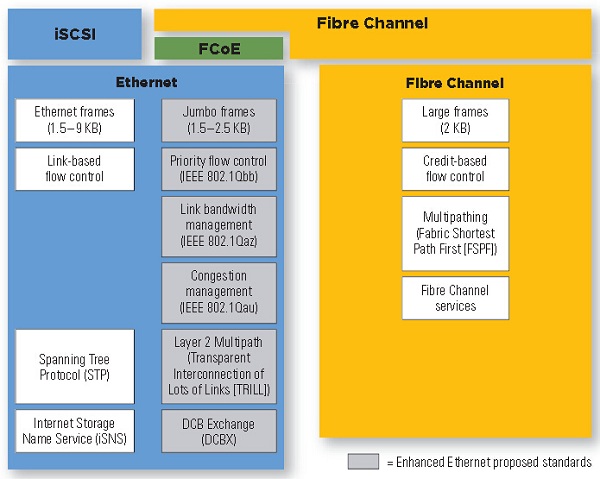10:00 AM Making the Case for 10 Gigabit Ethernet |
Several factors make 10GbE implementations a compelling option, including interoperability, cost efficiency, low power consumption, communication quality, and hardware availability. Each of these factors merits careful consideration. Interoperability Leveraging Existing Technology During infrastructure upgrades, 10GbE and the TCP/IP protocol are designed to interoperate seamlessly with GbE links, enabling a relatively easy and nondisruptive transition to 10GbE. Two different types of 10GbE connectors are expected to facilitate these links, including 10GBase-T copper and the 10GbE small form-factor pluggable+ (SFP+) interconnect. SFP+ supports different physical port types such as 10GBASE Twinax copper and various types of fiber connections. By helping ensure that the 10GbE components can cooperatively communicate with GbE devices, switch vendors can deliver interoperability between GbE and 10GbE. Data transitioning from 10GbE to GbE links potentially requires additional buffering on the 10GbE switch to temporarily store the data while it is being transmitted to a low-speed device. In addition, support can be provided for the expected Ethernet standard pause frames (IEEE 802.3x) and priority flow control standards that are part of the enhanced Ethernet standards. Cost Efficiency Resulting from Fewer Connections Over time, as 10GbE becomes commonplace, one 10GbE port is expected to be more cost-efficient than multiple GbE ports and Fibre Channel ports. Current GbE storage normally requires multiple ports to provide acceptable storage bandwidth between hosts and arrays. Based on industry best practices for redundancy, a minimum of two connections are used to provide a failover path between host and storage. Additional bandwidth may be required by the application—for example, the performance of sequential data applications such as data warehouses is typically gated by bandwidth. Another best practice is to isolate storage traffic on the SAN from client/server traffic on the LAN, which requires a separate LAN port. Dedicated management ports are often required as well. Just two 10GbE connections (for minimal redundancy) in conjunction with enhanced Ethernet standards such as DCB can handle these requirements while still upholding the best practices just described.
Low Power Consumption with SFP+ optics Since the 10GBase-T standard was adopted in 2007 for twisted-pair copper cabling, efforts have been underway to help reduce 10GBase-T power consumption—with a goal of reaching power levels per port that are equivalent to the current 1GBase-T standard. First-generation 10GBase-T adapters have higher wattage demands than their short-reach optical counterparts. Currently, prototype second-generation 10GBase-T implementations are designed to bring wattage demand per port down to reasonable levels. 10GbE SFP+, which today is an early implementation choice for network and storage vendors such as Dell, Cisco, HP, etc. that has very low wattage requirements per port, and SFP+ direct attach copper cable can provide a power-efficient, cost-effective 10 m cabling reach between rack-mounted servers and a top-of-rack switch. In SFP+ direct attach connections, the module is built into the cables (SFP+ cable). This effort, along with the reduction in the number of separate connections required to manage multiple networks, should help significantly reduce the power requirements of the network. Communication Quality with Compliant Standards The Data Center Bridging (DCB) standard is expected to encompass several IEEE 802.1 standards to help ensure communication quality for 10GbE and iSCSI deployments. Priority flow control (802.1Qbb), a link-level flow-control mechanism, is designed to ensure zero loss under congestion in DCB networks. Another standard, 802.1Qau, is intended to provide end-to-end congestion management. Hardware Availability to Mix GbE and 10GbE Hardware is available today for mixing GbE and 10GbE. For example, the Dell PowerConnect M8024 blade I/O switch modules can configure ports to run at GbE or 10GbE speeds and provide several options for physical connection types; SFP+ optics use in GbE and 10GbE Ethernet links, such as the Finisar FTLX8571D3BCV 1G/10G Dual-Rate SFP+ optical transceiver over multimode fiber and FTLX1471D3BCV 1G/10G Dual-Rate SFP+ optical transceiver link length up to 10km over singlemode fiber. When used in conjunction with an external 10GbE switch, such as the planned PowerConnect 8024F SFP+ switch, and legacy GbE switches, such as the PowerConnect 6200 series, this hardware is expected to offer several options for configuring iSCSI storage solutions that utilize mixed Ethernet speeds. Refers to Dell Mixing Gigabit Ethernet and 10 Gigabit Ethernet in a Dedicated SAN Infrastructure |
|
|
| Total comments: 0 | |

